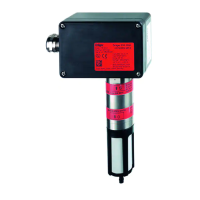Operational Characteristics
12
Make sure that the calibration adapter is correctly seated. To this end, manually
tighten the calibration adapter to a point where the sealing line leaves a permanent
mark on the splash guard.
Nitrogen, synthetic air or fresh air (hydrocarbon content <50 ppm) can be used for
zero point calibration.
Commercially available calibration gas can be used to calibrate the respective gas
category (methane, propane, ethylene). The highest accuracy is achieved using
test gas concentrations of 40 to 70 percent of the measurement span.
The infrared gas transmitter Dräger PIR 3000 can also be used to measure other
gases than mentioned above. For detailed information, refer to "Substitute Gas
Calibration" on page 16.
Select the measured gas in the corresponding table and determine the
corresponding gas category.
Set the gas transmitter to the determined gas category.
Where possible, calibration gas should match with the measured gas for span
calibration. In exceptional cases, span calibration can be carried out using a
suitable substitute gas and the associated calibration factor. The suitable substitute
gas as well as the associated calibration factor is shown in the table "Substitute
Gas Calibration" on page 16.
Select the substitute gas (gas category) and the calibration factor in table
"Substitute Gas Calibration" on page 16.
Multiply the concentration of the substitute gas by the calibration factor to get the
gas concentration to be set.
Example:
Measured gas: n-octane
Gas category: Propane (see table "Substitute Gas Calibration",
page 16)
Calibration factor: 1.8 (in table "Substitute Gas Calibration", page 16)
Span gas concentration: 40 %LEL propane (bottle concentration)
Setting: 40 %LEL x 1.8 (calibration factor) = 72 %LEL
CAUTION
Never inhale test gas. Danger to health!
Observe the safety information in the corresponding safety data sheets. Ensure
that gases are vented or otherwise guided outside the building.

